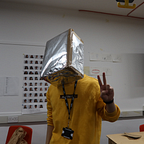22/04/21–10/06/21 (7 weeks)
📃Brief: Design a way to materialise the blockchain.
🤝Group Members: Alex Newson, Tatiana Bohsali, Sue Heeyeon An, Yiwei Han (David).
👁🗨External Partner: This Ain’t Rock’n’Roll — Charlie Waterhouse, Clive Russell
Project Launch Day
In the first two meetings, two members of This Ain’t Rock’n’Roll, Charlie and Clive, briefed us on the development of Brixton Pound and its collaborative project with Algorand(a blockchain platform) respectively. This gave us an initial idea and reference of what we would be designing next. But with no knowledge of blockchain and the Brixton community, we needed to answer these questions first: What is blockchain? How does it relate to Brixton and Brixton pound? What is materializing and How?
What is Blockchain?
Through online research, we have gained an initial understanding of Blockchain. Simply speaking, blockchain is a distributed ledger that is completely open to everyone.
It’s a time-stamped series of immutable records of data that is managed by a cluster of computers not owned by any single entity. Each of these blocks of data (i.e. block) is secured and bound to each other using cryptographic principles (i.e. chain).
So that’s why we are saying that it has industry-disrupting capabilities or abilities to eliminate third parties. Since it is a shared and immutable ledger, the information in it is open for anyone and everyone to see. Hence, anything that is built on the blockchain is by its very nature transparent and everyone involved is accountable for their actions. No central authority required, it is the very definition of a democratized system. (However, this may also cause certain problems).
Although the idea of an immutable ledger was proposed early on, the first Blockchain was devised and successfully applied in 2008. It was created to be used as a trading ledger for a digital cryptocurrency (Bitcoin).
How is the blockchain being built and maintained?
Trying to create a Blockchain is essentially impossible without the help of people — the information on the ledger needs to be written by people and verified by people. And people need incentives to encourage them to participate and labour. This incentive is the consensus mechanism, whose main function is to elect people who record new blocks and give them rewards (cryptocurrencies).
The two mainstream consensus mechanism are Proof of Work (PoW) and Proof of Stake (PoS). Pure Proof of Stake is developed by Algorand. The difference can be seen in the chart below:
We started to think about what aspect of blockchain are we materializing? How to make the introduction of blockchain and consensus mechanisms more interesting and easy to understand? I found that its consensus mechanism can be expressed in a game-like way, and came up with two kinds of mini-games.
What is Money or Value?
Money is an artificial construct. Not real, just a piece of paper, but has some TRUST in it. So could money be somthing else instead of paper or coins? What if alternative currency is actually something else? Can Blockchain help us subvert and rebuild the trust system? Alex and Tatiana also conducted an artefact analysis to see what values are found in objects other than money after our discussion and literature study on the value of money.
Presentation
In the presentation, Sue and I give a quick introduction to the concept and history of Blockchain and introduce the PoW mechanism through a game. Tatiana and Alex present some Blockchain applications in different domains, artefact analysis and the cultural characteristics of Brixton. Finally, we also discuss the current metaphors in society’s language about money and Blockchain.
Summary
During the week, we discovered that Brixton Pound and Blockchain share similar anti-social centralisation properties, bringing ownership, access to information and greater opportunity back to people. It is the antithesis of big manipulative capital paradigm.
We need to think about: Should we leverage this unique property to challenge and critique the current mainstream capital exchange? How can we promote blockchain to the masses and not just be used by techies? by using the approch of physical materialization or digital materialization or both?
Over the next week, we decided to micro-analyse the process of buying cryptocurrencies in order to gain a detailed understanding of the current mainstream blockchain applications and to conduct field research in Brixton for inspiration.
📚References
Bitcoin (2009). Bitcoin — Open source P2P money. [online] Bitcoin.org. Available at: https://bitcoin.org/en/ [Accessed 5 Jun. 2021].
Elsden, C., Feltwell, T., Lawson, S. and Vines, J. (2019) Recipes for programmable money. In Proceedings of the 2019 CHI Conference on Human Factors in Computing Systems (pp. 1–13).
Foreman, E. (2018). An Interview With Brixton Pound. [online] The Social Change Agency. Available at: https://thesocialchangeagency.org/an-interview-with-brixton-pound/ [Accessed 5 Jun. 2021].
Lakoff, G. and Johnson, M. (1980) Metaphors We Live By. Chicago: University of Chicago Press.
Nicolaisen, J., 2017. What should the future form of our money be?.
